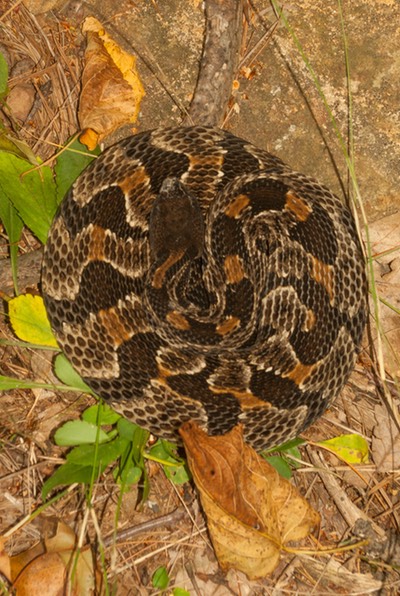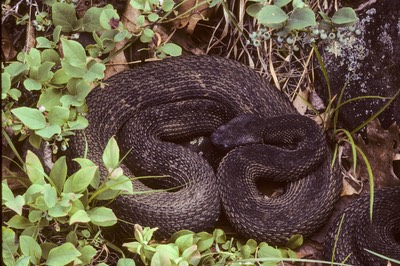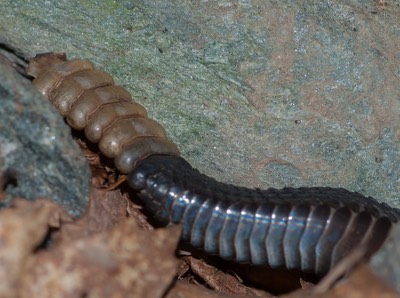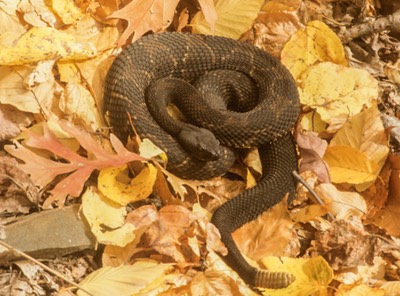
No other snake in Western Massachusetts has the history, lore, fiction, and fascination as the Timber Rattlesnake. Long a symbol for many pre- and post-Colonial political statements, this snake, more than any other, remains an emblem of the last vestiges of wilderness left in the 21st century. The fact that it is also venomous simply adds to its allure.

And, of course, there’s that rattle. This structure is unique to the group of New World pit vipers, including about 32 species that extend from southern Canada to northern South America. Neonates are born with a sheath (called the prebutton) that covers their first rattle segment (the button); within two weeks after birth, the prebutton is shed, revealing the button. At each subsequent shedding a new segment is added at the base, pushing older ones farther away. This sequence from new (and larger) segments to the oldest (and smaller) segments near the tip leads to changes over time. Younger snakes show a clear taper to the tip of the rattle (see right), while older timbers exhibit an even, parallel-sided rattle string. Very few snakes in natural conditions have long and complete (still retaining the button) strings. Distal segments break readily; only luck and really good eyesight will reveal partial rattles on the ground.
The Timber Rattlesnakes is found in 30 states in the eastern US. In most of those states, however, populations have experienced minor to severe declines. They are already extirpated from Maine and Rhode Island and are endangered in the rest of New England. Other snakes may shake their tails (in leaf litter or dried grasses), perhaps as an auditory mimicry of rattlesnakes. However, real rattlesnakes really have to be rattled to rattle their rattle. Most of the time, especially when basking, they sit on their rattle or at least lay it next to their bodies, making it difficult to see.
More data have been collected on this species than any other snake in Western Massachusetts. Radiotelemetry, mark-and-recapture, head-starting, DNA sequencing, blood analysis, annual surveys, and some habitat management have been undertaken for the sake of the Timber Rattlesnake in our state. This is no surprise—it is one of the most endangered terrestrial vertebrates not only here, but in all the Northeast. The success of these efforts will be evident only if populations survive decades into the future. Increased development, road mortality, poaching, purposeful killing, climate change, emerging disease, off-road vehicle abuse, genetic bottlenecking, and other affronts are ongoing problems.

Timber Rattlesnake basking on lichen-covered rocks
Results from field work show that individual rattlesnakes demonstrate remarkable fidelity not only to winter dens, but also to basking, feeding, and birthing areas. Snakes have been tracked nearly 4 miles from their dens, traversing hills, valleys, streams, fields, property boundaries, roads, and forest types. Local populations may require at least 1,000 acres of (mostly forested) land to survive, about the same space a pair of Pileated Woodpeckers need to find enough food in winter.
In the history of the State, only three human deaths are attributed to Timber Rattlesnakes; two occurred in Western Massachusetts (one in 1761, the other in 1850). One case is widely known as it became the subject of the first purely American folk song. Called Springfield Mountain or The Pesky Sarpent, there are many recorded versions; the first I ever heard was from Massachusetts singer Paul Clayton. Click below to hear it. UMass graduate and fabulous singer/songwriter Mark Erelli has reworked this song, played it a few times in recent years, but has yet to put it on a CD. Send him a note and ask him to do so!
Paul Clayton’s version of Springfield Mountain:
While we’re on the subject of music, I want to direct your attention to The Snake Song by Jonathan Byrd. This sweet ballad was part of his 2003 Waitress album. If it hasn’t been done yet, I can see some talented writer/artist turning his lyrics into a great nature-oriented children’s book.
Only three Timber Rattlesnake bites have been reported in recent years. I happened to be on the scene for two of them (one in 1970, the other in 2010). The first was a case of ignorance; the second was a complete accident. Both were off trails where vegetation was dense. Hint: stay on trails in the few places these snakes survive and you may be lucky enough to see one. If you do, log a report here.




